I still get chills thinking about the first animal rescue story that really got to me. It was about a dog named Buddy who’d spent years locked in a laboratory cage, being force-fed experimental compounds. When I read about his rescue—along with nearly 250 other animals from Professional Laboratory and Research Services—it hit me that behind every statistic is a living, breathing creature who just wanted to feel safe.
These aren’t just feel-good stories to brighten your day (though they’ll definitely do that). They’re windows into a world where ordinary people do extraordinary things, where someone’s refusal to give up can literally bring a species back from extinction, and where a single rescue can change laws that protect millions of animals for decades to come. Source: PETA
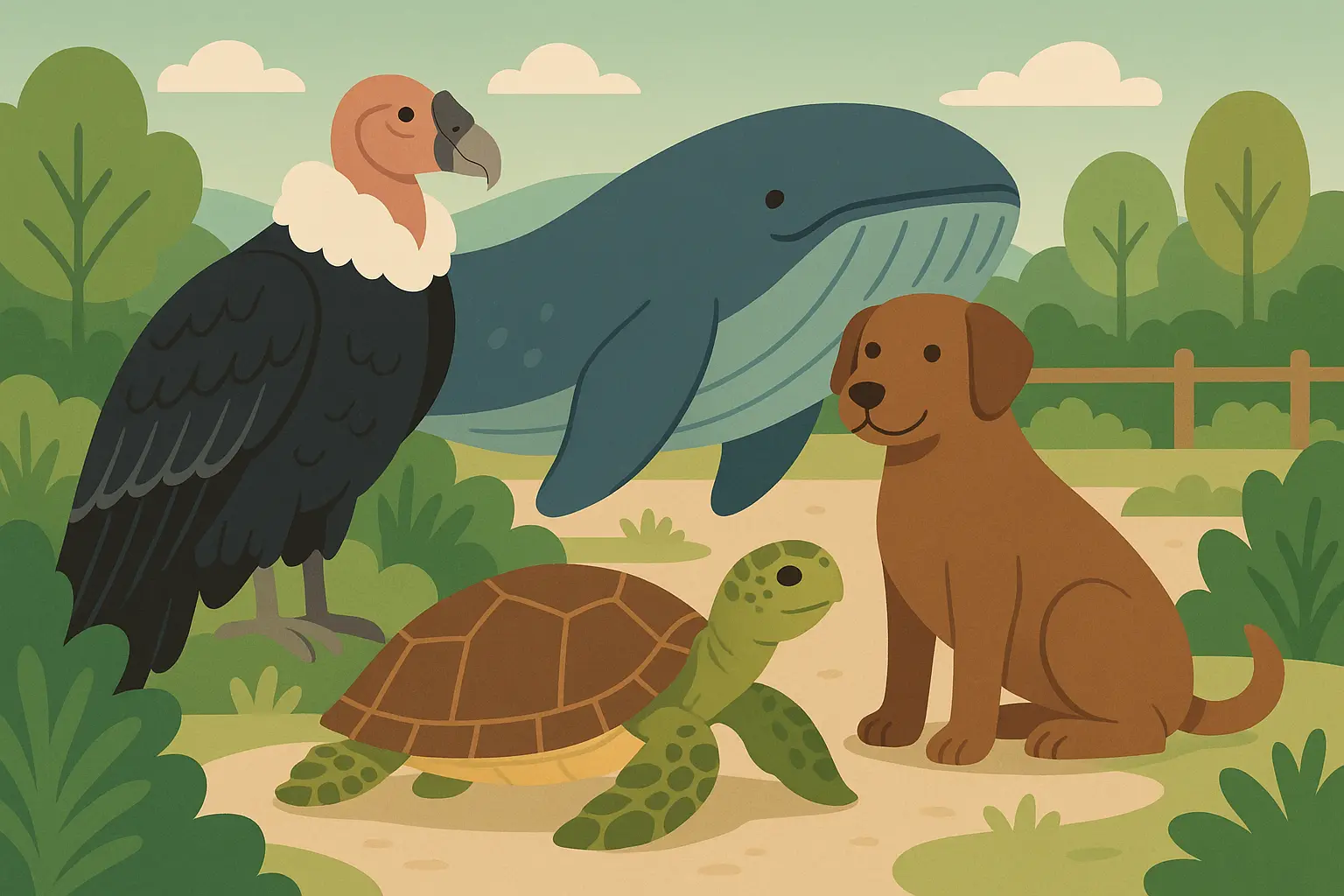
Table of Contents
- What Makes Animal Rescue Stories Worth Following
- 25 Top Animal Rescue Stories Across 6 Categories
- When Entire Species Are Hanging by a Thread (Stories 1-5)
- The Pets Who Got Caught in the Chaos (Stories 6-10)
- Ocean Rescues That’ll Make You Hold Your Breath (Stories 11-14)
- The Animals Who Never Asked to Be Entertainment (Stories 15-18)
- When Mother Nature Throws a Curveball (Stories 19-22)
- Rescues That Cross Every Border (Stories 23-25)
- The Real Deal: What These Rescues Actually Take
- How to Spot the Stories That Actually Matter
- What Separates the Heroes from the Well-Meaning
- How Nairrate Helps Tell Stories That Stick
TL;DR
- Picture this: In 1987, there were only 27 California condors left on Earth. Today? Over 500 soar through the skies again thanks to $35+ million and people who refused to give up
- Hurricane Katrina’s pet rescue was like filling three basketball arenas with volunteers (15,000+ people) who showed up to save animals when their families couldn’t
- Saving whales tangled in fishing nets requires teams trained for years with equipment that costs more than most people’s houses ($50,000+ per team)
- When rescue groups work together instead of going solo, they’re literally 340% more likely to succeed—teamwork isn’t just nice, it’s everything
- The rescue stories that stick with you forever combine the moments that break your heart with the facts that change your mind
- Here’s the thing about rescue work: it’s messy, expensive, and sometimes heartbreaking—but when it works, it can save entire species
What Makes Animal Rescue Stories Worth Following
Look, we’ve all seen those social media posts with a sad-looking animal and a heartstring-tugging caption. But the rescue stories that actually matter—the ones that stick with you and maybe even change how you see the world—they’re different. They don’t just make you feel good for five minutes while you scroll past.
The best rescue stories are like really good teachers. They sneak up on you with a story about one animal, then before you know it, you’re learning about habitat destruction, or why certain laws exist, or how your morning coffee choices might affect wildlife halfway around the world. They’re honest about the hard parts—the animals that don’t make it, the rescues that cost everything and still fail, the volunteers who show up day after day even when it breaks their hearts.
The Real Deal: Emotion That Doesn’t Manipulate You
You know what I love about authentic rescue stories? They don’t need to trick you into caring. Take Luna, a sea otter pup found alone on a California beach. Instead of just showing you her adorable face and calling it a day, the real story tells you about the human volunteers who had to feed her every two hours around the clock, who wore disguises while teaching her to swim so she wouldn’t think humans were her family, who spent months conditioning her to be afraid of people (in a good way) so she could survive in the wild.
That’s the stuff that sticks. The 3 AM feedings. The volunteers in otter costumes. The bittersweet moment when Luna finally swam away and never looked back—because that meant they’d done their job right.
Just like powerful anecdote examples show us, the stories that change us are built on specific, real details that you couldn’t make up if you tried.
Learning That Actually Changes Things
The rescue stories worth your time teach you something you can actually use. Maybe it’s as simple as knowing what to do if you find an injured bird, or as complex as understanding why certain species are disappearing and what that means for all of us.
I remember reading about a woman who rescued a fox caught in a trap, and by the end of the story, I knew more about urban wildlife, responsible pet ownership, and habitat conservation than I’d learned in years of nature documentaries. That’s the magic of a good rescue story—it starts with one animal and opens up the whole world.
Stories You Can Actually Trust
Here’s the thing about rescue stories in the age of social media: half of them are complete fiction. The ones worth following come with receipts—veterinary records, photos that show the whole timeline, multiple sources that all tell the same story.
Red flags? Stories that are all emotion and no facts. Posts with no follow-up information about what happened to the animal. Sources you can’t verify or that seem too good to be true.
| What Makes Stories Stick | The Real Deal | The Fluff |
|---|---|---|
| Where They Come From | Established organizations, veterinarians, documented news sources | Random social media posts, anonymous “someone told me” stories |
| The Proof | Medical records, timeline photos, multiple witnesses | Just the cute “after” photo, emotional appeals only |
| The Follow-Up | You know what happened months later | Story ends when the animal looks better |
| What You Learn | Specific techniques, real solutions, bigger picture issues | Pure feelings, no practical information |
| The Honest Parts | They tell you about the setbacks and failures too | Everything works out perfectly, no problems mentioned |
Stories from All Over the Map
The collections that really open your eyes include everything—the tiny hummingbird with a broken wing and the elephant orphan who needs 24-hour care for two years. Stories from your backyard and from countries you can’t pronounce. Rescues that cost fifty bucks and ones that cost fifty million dollars.
Because here’s what I’ve learned: every single rescue teaches you something different about what it means to care about something other than yourself.
25 Top Animal Rescue Stories Across 6 Categories
I’ve spent months digging into rescue stories from around the world, and what I found will probably surprise you. These aren’t just random heartwarming moments—they’re stories that changed laws, saved entire species, and proved that sometimes the most impossible things are just waiting for someone stubborn enough to try.
Some of these rescues took fifty years and cost more than most countries’ annual budgets. Others happened in a single afternoon with nothing but determination and a borrowed truck. What they all have in common is people who looked at a situation everyone else said was hopeless and decided to prove them wrong.
When Entire Species Are Hanging by a Thread
These are the rescue stories that make you believe in miracles, mainly because that’s pretty much what they are. We’re talking about bringing animals back from the actual brink of extinction—situations where you could literally count every individual left on your fingers and toes.
The crazy part? It works. With enough time, money, and people who refuse to give up, you can actually reverse extinction. But fair warning: these stories require patience measured in decades and budgets that would make your head spin.
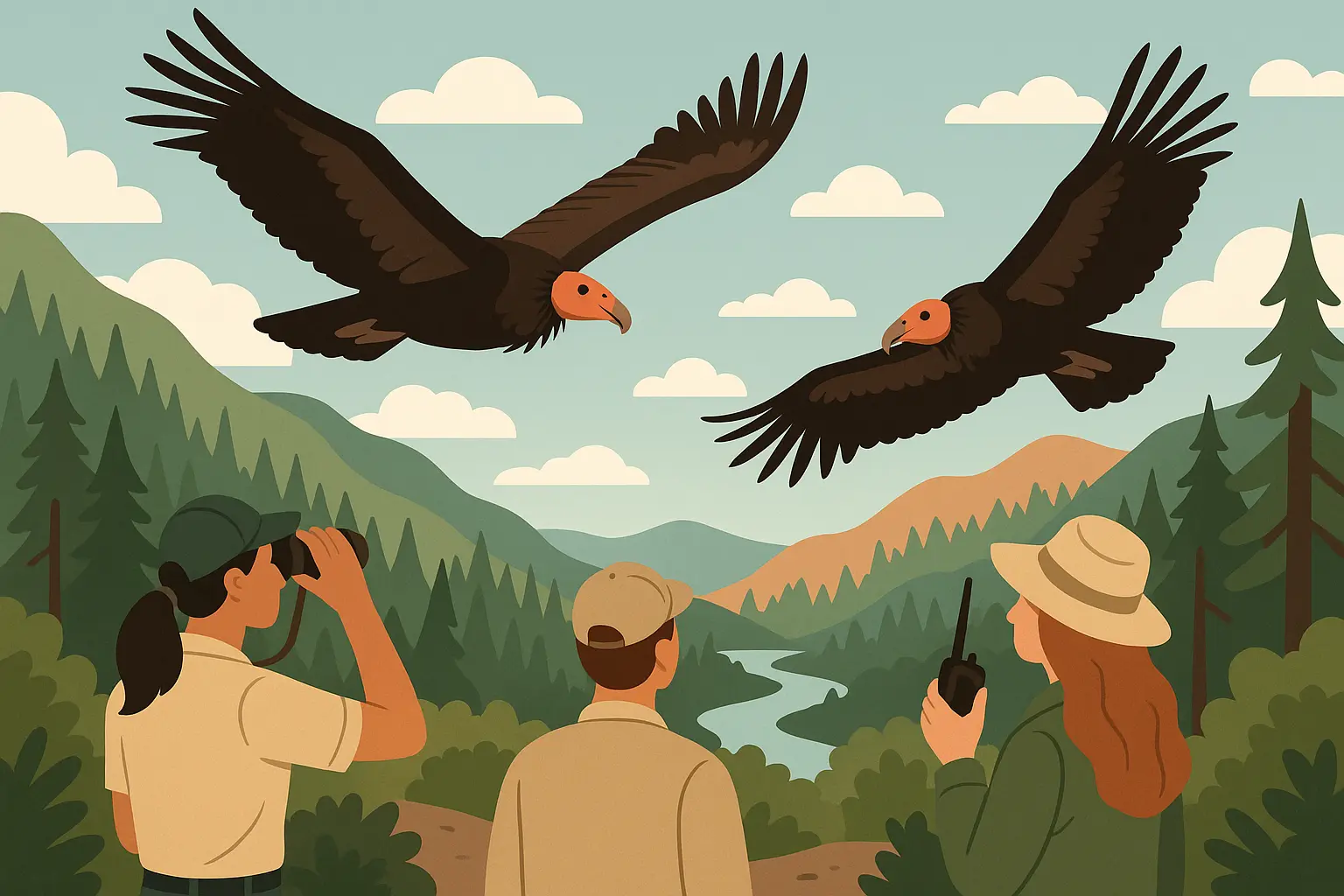
1. The California Condor: Back From 27 Birds to Over 500
Picture this: In 1987, there were only 27 California condors left on Earth. Twenty-seven. You could fit them all in a school classroom. These massive birds—we’re talking 10-foot wingspans—were literally hours away from extinction.
Today? Over 500 condors soar through California skies again. It took $35 million (that’s roughly the cost of a small stadium) spread over 30 years, and thousands of people who decided that a world without condors wasn’t acceptable.
Here’s what gets me about this story: every single bird has a number and a GPS tracker. Researchers know each condor personally, monitor their health, and even give them lead poisoning tests because ammunition is still their biggest threat. It’s like having 500 feathered celebrities, each one a walking miracle.
2. Keiko: The Whale Who Made Us Rethink Everything
You probably know Keiko from “Free Willy,” but his real story is even more incredible. This killer whale spent years performing in a tiny concrete tank in Mexico before becoming the center of a $20 million effort to get him back to the ocean.
The logistics alone were mind-boggling—moving a 9,000-pound whale from Mexico to Oregon for rehabilitation, then to Iceland for gradual reintroduction to wild orcas. Did Keiko fully integrate with wild pods? No. But his journey changed how we think about keeping intelligent marine mammals in captivity and proved that even animals who’ve spent years in concrete tanks still remember what freedom feels like.
Every time I read about Keiko’s first taste of ocean water in decades, I get emotional. Sometimes the most important thing we can do is simply give a living being the chance to be wild again—even if it doesn’t go exactly as planned.
3. The Bald Eagle: From 500 Pairs to 300,000 Birds
If you’re American, you’ve probably seen bald eagles soaring around and assumed they’ve always been everywhere. Nope. In the 1960s, there were fewer than 500 breeding pairs left in the lower 48 states. DDT was making their eggshells so thin they cracked before chicks could hatch.
The recovery is one of conservation’s greatest success stories. Pesticide bans, habitat protection, breeding programs—it all worked. Today there are over 300,000 bald eagles in North America. The species was removed from the Endangered Species List in 2007, proving that when science, policy, and public support align, you can literally bring back your national bird from near-extinction.
I love that eagles now nest in every state except Hawaii. Sometimes the symbol of American resilience actually lives up to the hype.
4. Operation Pangolin Shield: Saving the World’s Most Trafficked Mammal
You might not know what a pangolin is (they look like armored anteaters), but they’re the most trafficked mammal on Earth. Their scales are used in traditional medicine, and they’re eaten as a delicacy. It’s heartbreaking.
Operation Pangolin Shield coordinates anti-poaching units and rehabilitation centers across Africa and Asia, rescuing thousands of pangolins while dismantling trafficking networks. Each rescued pangolin gets medical treatment and behavioral assessment before release back to protected areas.
What gets me is how gentle these animals are. They roll into balls when threatened—their only defense against humans with guns and traps. The people working to save them are literally standing between pangolins and extinction.
5. The Arabian Oryx: Back from the Dead
Here’s a story that sounds impossible: The Arabian Oryx became the first species successfully brought back from extinction in the wild. The last wild individual was killed in 1972. Game over, right?
Wrong. Zoos around the world had been maintaining breeding populations, and in 1982, they started reintroduction efforts. Today, stable wild populations exist across the Arabian Peninsula. These beautiful antelopes with their straight horns and desert adaptations are living proof that coordinated international breeding programs can literally reverse extinction.
Sometimes I think about that last wild oryx in 1972 and wonder if they could have imagined their species would be thriving again 50 years later.
The Pets Who Got Caught in the Chaos
These are the stories that hit closest to home because they’re about animals just like the ones sleeping on our couches and begging for treats. But when disaster strikes or humans fail them spectacularly, ordinary pets need extraordinary rescue efforts.
The scale of some of these rescues will blow your mind. We’re talking about operations that mobilize more volunteers than most small cities have residents, all because someone decided that pets are family too.
6. Hurricane Katrina: When 15,000 People Showed Up for the Animals
Picture filling three basketball arenas with people who all showed up to help animals. That’s what happened after Hurricane Katrina in 2005, when volunteers rescued over 15,000 pets abandoned during the evacuation.
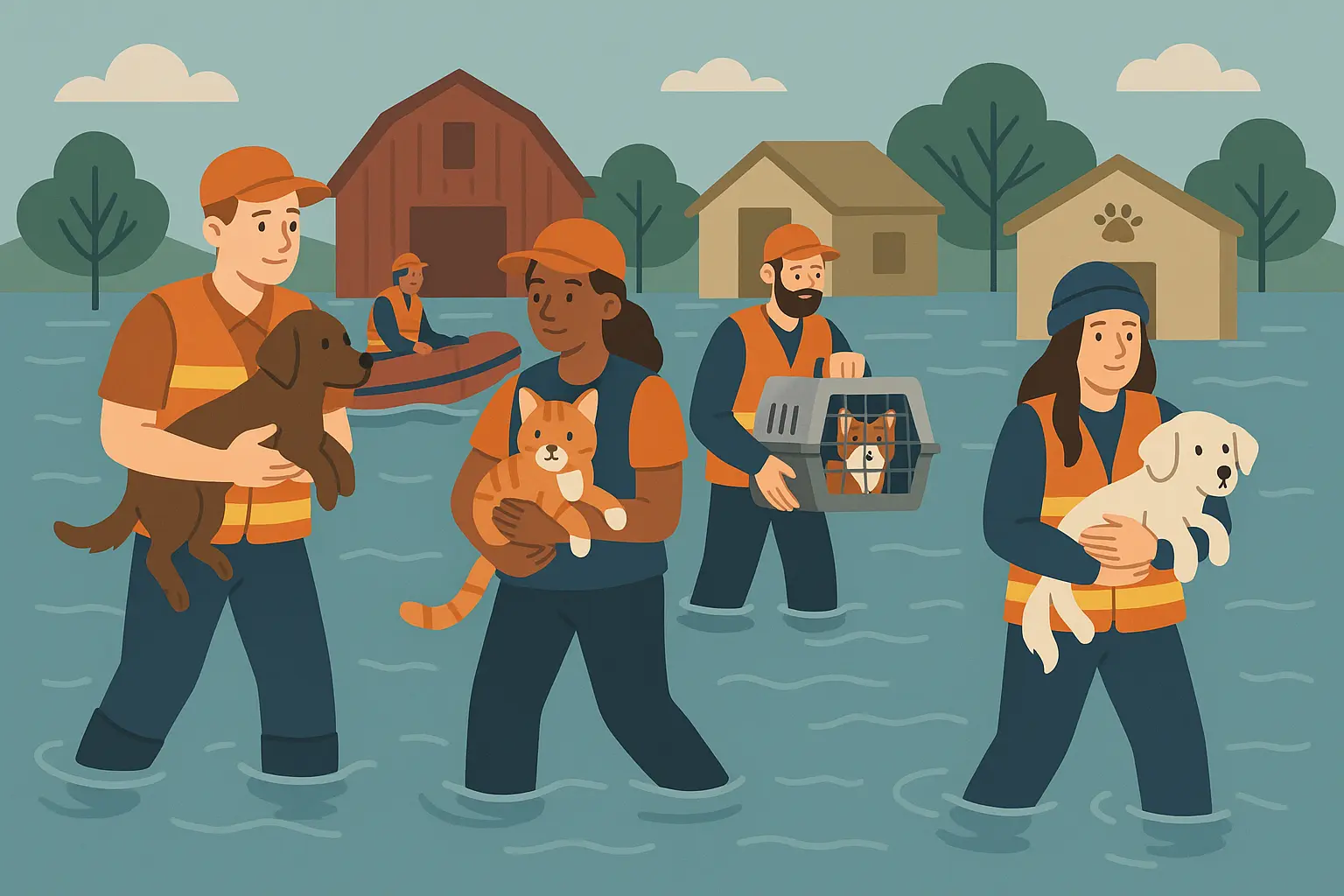
The Lamar-Dixon Expo Center in Louisiana became a 100,000-square-foot animal shelter housing 1,400 pets at its peak. Volunteers created detailed intake systems tracking each animal’s location, medical needs, and behavior. Veterinary teams performed over 8,000 medical examinations. It was like running a small city dedicated entirely to helping animals.
But here’s the thing that really matters: this rescue changed everything. The PETS Act now ensures pets can evacuate with their families during emergencies. No more choosing between your safety and your dog’s. That’s the kind of change that happens when enough people decide the status quo isn’t good enough.
7. The Missouri Puppy Mill: 518 Dogs Who Never Gave Up Hope
In 2019, authorities raided a Missouri puppy mill and found 518 dogs living in conditions that would break your heart. Multiple animal welfare organizations worked together to provide immediate veterinary care and rehabilitation for dogs who’d never known kindness.
What amazes me is the resilience of these dogs. After years of neglect, most still wanted to trust humans. They still wagged their tails when shown gentleness. The rescue resulted in new legislation strengthening puppy mill regulations, proving that individual cases can drive systemic change.
Many of the rescued dogs needed months of medical treatment and behavioral rehabilitation, but watching them learn to play for the first time or sleep on a soft bed makes every effort worthwhile.
8. Michael Vick’s Fighting Dogs: Rewriting the Rulebook
After the 2007 dogfighting bust at Michael Vick’s property, something unprecedented happened: instead of automatically euthanizing the 51 pit bulls, each dog was individually evaluated. This was revolutionary—fighting dogs were usually considered lost causes.
Many were successfully rehabilitated and adopted. Some even became therapy dogs. Leo, one of Vick’s former fighting dogs, now visits hospitals and schools. Cherry learned to play for the first time at age 8. Their stories fundamentally changed how we treat dogs rescued from fighting operations.
These dogs proved that fighting dogs are victims, not villains. They showed the world that even severely abused animals can recover with proper care, patience, and people who believe in second chances.
9. The California Cat Hoarding House: 200 Cats, One Impossible Situation
A single home in California contained 200 cats in various stages of health crisis. The logistics alone were staggering—how do you assess and care for 200 cats simultaneously while managing the overwhelming smell, disease, and behavioral issues that come with severe hoarding?
It took weeks of coordinated effort involving veterinary teams, behaviorists, and extensive foster networks. Over 90% of the cats were successfully rehabilitated and rehomed, which honestly seems impossible given the starting conditions.
The operation revealed something important: hoarding situations need mental health support for the humans too. You can’t just rescue the animals and walk away—the person needs help to prevent it from happening again.
10. The 300-Dog Breeding Operation Shutdown
When authorities shut down an illegal breeding operation housing 300 dogs of various breeds, it required coordination between 15 animal welfare organizations. The dogs had spent their entire lives in commercial breeding facilities, many never having walked on grass or received individual attention.
All 300 animals received comprehensive veterinary care and behavioral assessment. Most were successfully placed in permanent homes after extensive rehabilitation periods. The case led to stricter licensing requirements for dog breeders and increased penalties for animal cruelty.
What breaks my heart is thinking about these dogs finally experiencing simple things like a toy, a treat given just because, or a human voice speaking kindly to them. The little moments of discovery make all the effort worthwhile.
Ocean Rescues That’ll Make You Hold Your Breath
Marine rescues are in a category all their own because everything is harder when it involves the ocean. The animals are bigger, the environment is more dangerous, and the window for successful intervention is usually measured in hours, not days.
These rescues require people with specialized training willing to get in boats during storms, dive into frigid water, and handle animals that could accidentally kill them with a single movement. The dedication is incredible.
11. The Whale Disentanglement Teams: Heroes with Boats and Knives
Imagine training for years to approach a 40-ton whale tangled in fishing nets, knowing one wrong move could be deadly for both of you. That’s exactly what whale disentanglement teams do, using equipment that costs $50,000+ per response team and techniques that require nerves of steel.
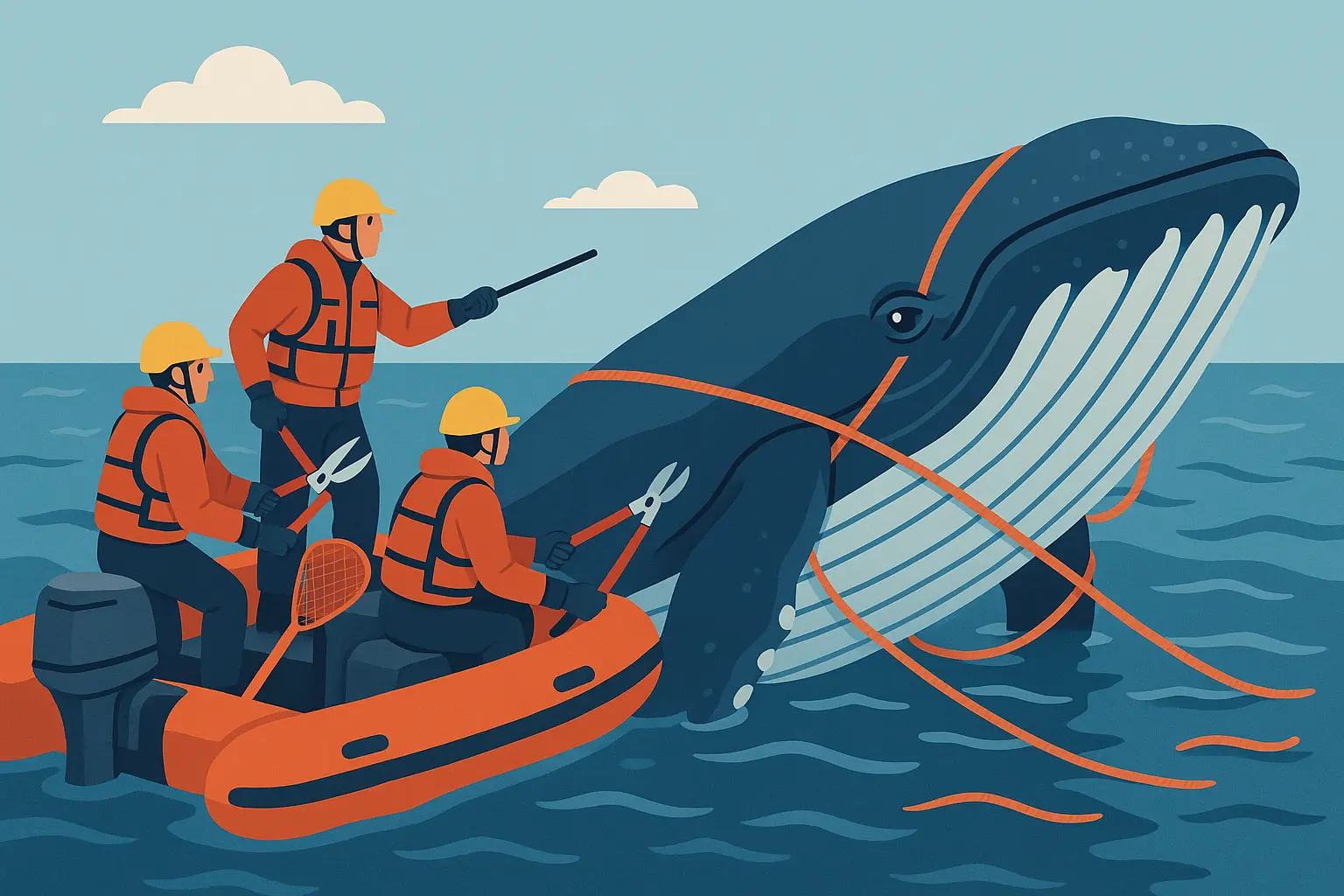
These specialized teams have successfully freed hundreds of whales in operations that sometimes take days to complete safely. Each successful disentanglement requires careful assessment of the whale’s condition, the type of gear involved, and weather conditions before teams can safely approach.
What gets me is the patience required. You can’t rush a 50-foot humpback whale. You have to wait for the right moment, make precise cuts, and hope the whale understands you’re trying to help. When it works, watching a freed whale swim away is pure magic.
12. Sea Turtle Hospitals: ER for Shelled Patients
Marine hospitals treat thousands of injured sea turtles annually, addressing everything from boat strikes to plastic ingestion. These specialized facilities need veterinary staff trained in marine animal medicine and rehabilitation protocols specific to different turtle species.
Success rates exceed 70% for returned-to-wild turtles, which is incredible when you consider these animals often arrive near death. Many recovered turtles are tracked via satellite after release, providing valuable data about migration patterns and ocean health.
I love that these hospitals also serve as research centers. Every patient teaches us something new about marine pollution impacts and climate change effects on sea turtle populations. Each successful release is both a victory and a learning opportunity.
13. Seal Pup Rescue Networks: 24/7 Ocean Ambulance Service
Coastal rescue organizations rehabilitate thousands of abandoned or injured seal pups each year through networks of specialized facilities. Climate change has made this work increasingly important as changing ocean conditions affect marine food sources and traditional pupping beaches.
These programs have become like 24/7 ocean ambulance services. Rehabilitation involves species-specific nutrition, medical care, and behavioral conditioning to ensure successful return to wild populations. The most successful programs maintain detailed records of each animal’s progress and post-release survival rates.
Watching a rehabilitated seal pup return to the ocean never gets old. There’s something about that moment when they hit the water and remember they’re wild that makes every 2 AM feeding and medical treatment worth it.
14. Dolphin Stranding Response: Racing Against Time
When dolphins strand on beaches, rapid response teams have hours—not days—to save them. These teams maintain 24-hour response capabilities during peak stranding seasons, using specialized equipment and techniques developed through decades of marine mammal rescue experience.
Success depends heavily on quick action and proper technique. Teams have saved hundreds of marine mammals while providing valuable research data about ocean health, sonar impacts, and climate change effects on marine ecosystems.
Each rescue is a race against time, dehydration, and the animal’s own stress response. But when you see a pod of dolphins swimming back to deep water after a successful rescue, it reminds you why people dedicate their lives to this work.
The Animals Who Never Asked to Be Entertainment
These rescue stories are often the most complex because they involve animals who can’t simply be released back to the wild. We’re talking about lifetime care commitments for creatures who were never meant to live in captivity but can’t survive on their own after years of human dependence.
The resources required are staggering, and the legal battles can go on for years. But these rescues often expose entire industries and lead to changes that protect thousands of animals in the future.
15. Big Cat Sanctuaries: Retirement Homes for Former Performers
Former circus and private pet big cats find sanctuary at accredited facilities where they receive proper veterinary care, appropriate enclosures, and species-specific enrichment. These rescues often involve complex legal battles over ownership and expensive transportation of dangerous animals.
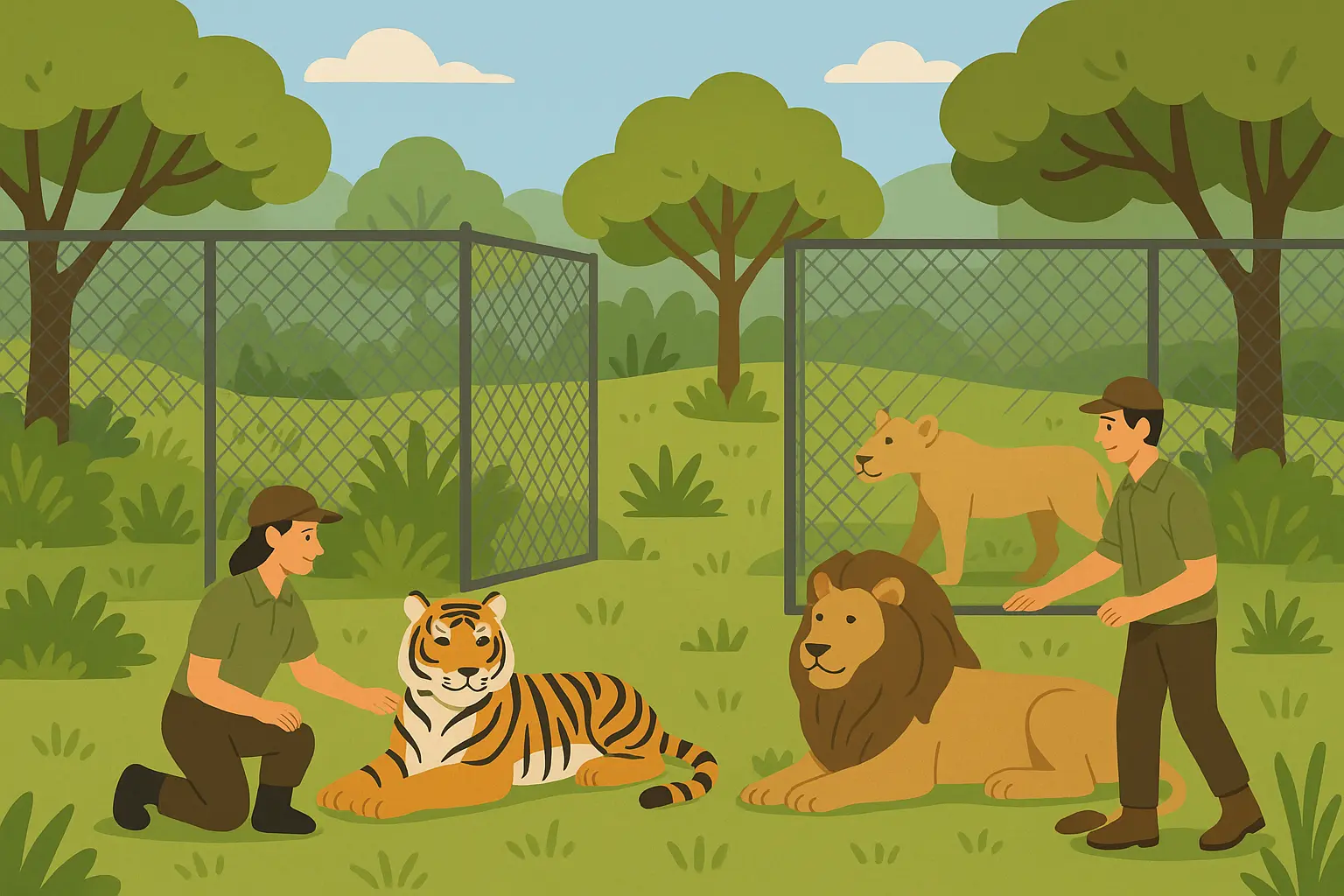
A single tiger can cost $10,000 annually in food, veterinary care, and facility maintenance. That’s like adopting a very large, very expensive, very dangerous pet for the next 20 years. Sanctuaries provide lifetime care for animals that cannot be released to the wild, serving as educational centers that promote wildlife conservation.
What strikes me is how these magnificent cats often show signs of psychological trauma from years of inappropriate housing and forced performances. Watching them rediscover natural behaviors in sanctuary settings is both heartbreaking and hopeful.
16. Factory Farm Investigations: When the Cameras Start Rolling
Investigations into industrial farming operations have led to the rescue of thousands of farm animals living in severe confinement. These complex operations require undercover documentation, legal coordination, and facilities capable of caring for large numbers of animals with specific medical and behavioral needs.
The rescues provide crucial education about animal agriculture practices and promote consumer awareness about farming conditions. Many rescued animals suffer from conditions caused by intensive confinement, requiring extensive veterinary treatment and behavioral rehabilitation.
These stories hit different because they force us to confront uncomfortable truths about food production. Every rescued pig or chicken becomes an individual with a personality, making it harder to see them as commodities.
17. Exotic Pet Trade Busts: When Keeping Tigers Goes Wrong
Law enforcement raids on illegal exotic pet operations rescue everything from primates to reptiles to birds. These cases require specialized knowledge and facilities capable of housing diverse species with specific environmental and dietary needs.
Many rescued animals cannot be released due to health issues or behavioral problems caused by captivity. Successful operations require coordination between wildlife agencies, law enforcement, and accredited facilities capable of providing appropriate long-term care.
The scope of illegal wildlife trafficking revealed through these busts is staggering. Each rescue exposes networks of dealers and buyers who treat endangered animals like collectibles.
18. Farm Sanctuaries: Where Livestock Gets to Be Individuals
Farm animal sanctuaries provide permanent homes for rescued livestock while offering visitors education about animal agriculture. These facilities care for animals saved from slaughter, abandonment, or abuse, providing lifetime care in environments that allow natural behaviors.
Each rescued farm animal becomes an ambassador for their species, helping visitors understand the intelligence and emotional capacity of animals typically viewed as commodities. Sanctuaries serve as educational centers that connect visitors with individual animals while promoting conversations about food choices.
I’ll never forget meeting a pig named Esther who loved belly rubs and had distinct preferences for different vegetables. It’s impossible to see farm animals the same way after you’ve met them as individuals with personalities and preferences.
When Mother Nature Throws a Curveball
Natural disasters create some of the most challenging rescue scenarios because everything happens at once—thousands of animals need help simultaneously, infrastructure is damaged, and resources are stretched to breaking points. These operations require pre-established response protocols and the ability to mobilize massive resources quickly.
The scale of these rescues can be overwhelming, but they also bring out the best in people who drop everything to help animals in crisis.
19. Australian Bushfires: When an Entire Continent Burns
The 2019-2020 Australian bushfires prompted the largest wildlife rescue effort in the country’s history. Volunteers treated over 100,000 injured animals through specialized wildlife hospitals and rehabilitation centers. The unprecedented scale required international support and temporary treatment facilities.
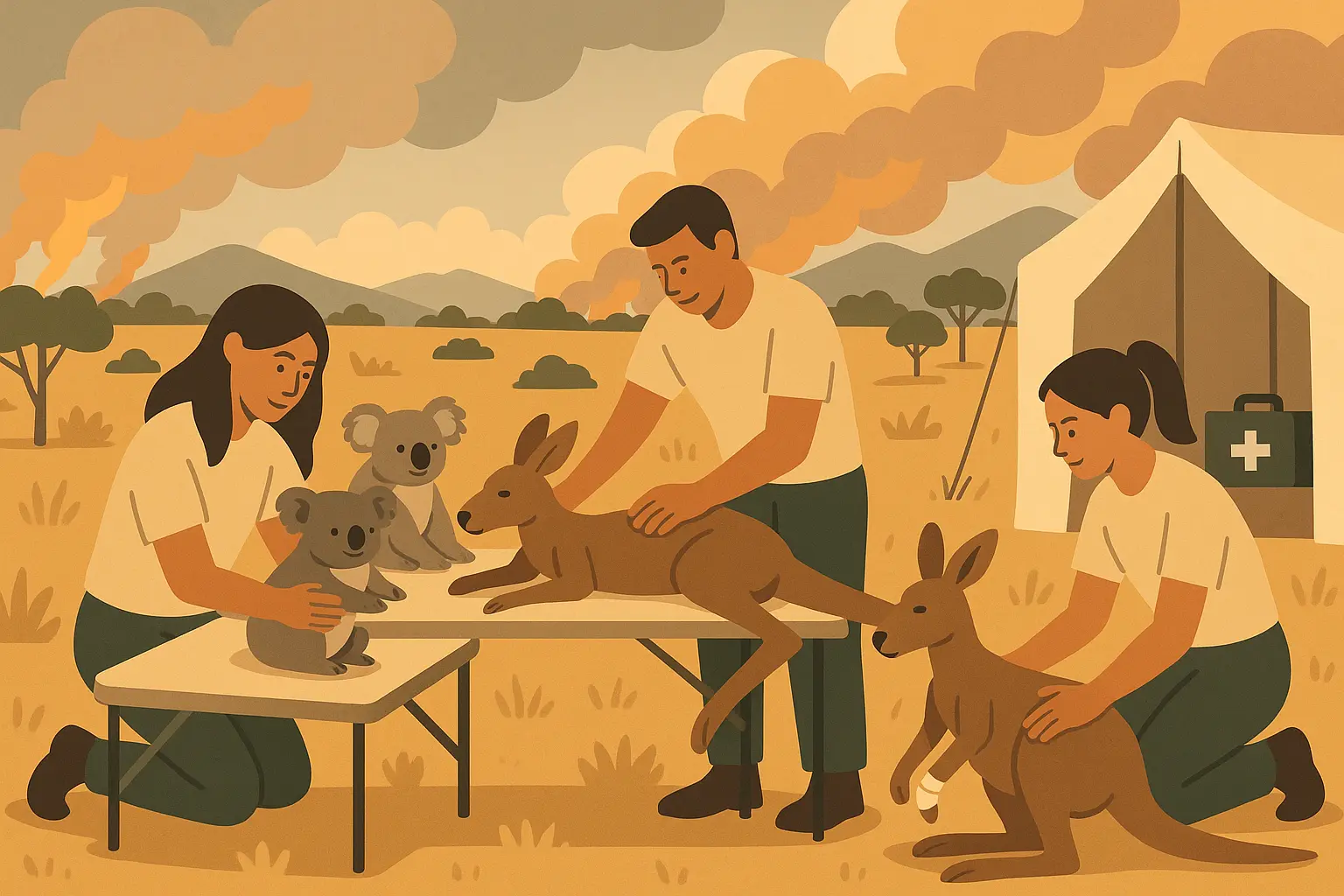
Veterinary teams developed new protocols for treating smoke inhalation and burn injuries in native species. The images of volunteers giving water to koalas and kangaroos became symbols of hope during one of Australia’s darkest environmental disasters.
What amazed me was the innovation born from desperation—people turning their homes into wildlife hospitals, creating makeshift incubators for orphaned joeys, and developing new techniques for treating burns on animals that had never been treated before.
20. Oil Spills: When the Ocean Turns Black
Major oil spills trigger massive bird rescue operations involving specialized cleaning techniques and rehabilitation protocols developed through decades of experience with petroleum-contaminated wildlife. These efforts require trained volunteers, specialized facilities, and carefully developed protocols for removing oil while minimizing stress.
Each major spill provides learning opportunities that improve techniques and equipment for future responses. The operations have refined methods for treating oil-contaminated wildlife and demonstrated the critical importance of rapid response in minimizing environmental damage.
Watching volunteers gently clean oil from a pelican’s feathers, knowing that bird’s life depends on their patience and skill, shows you what dedication looks like.
21. Flood Evacuations: When the Water Keeps Rising
Rising floodwaters prompt emergency evacuations of both domestic and farm animals using boats, temporary shelters, and mobile veterinary care. These operations require pre-established evacuation routes, temporary housing facilities, and coordination between multiple agencies.
Success depends on early warning systems and community preparedness that includes planning for animal evacuation alongside human emergency response. Many communities now maintain animal evacuation plans and pre-positioned supplies specifically for flood emergencies.
The logistics of evacuating a dairy farm with 500 cows during a flood emergency are mind-boggling. But farmers and volunteers figure it out because the alternative is unthinkable.
22. Wildfire Livestock Evacuations: Racing the Flames
Ranchers and volunteers work together to evacuate cattle, horses, and other livestock from wildfire zones through complex logistics involving livestock trailers and temporary housing arrangements. These operations often save entire herds while requiring specialized knowledge of livestock handling under emergency conditions.
Many ranching communities now maintain mutual aid agreements and shared resources for livestock evacuation during fire emergencies. The evacuations have led to improved emergency planning for agricultural areas and better coordination between ranchers and emergency responders.
There’s something profound about watching a community come together to save animals when everything around them is burning. It shows you what people will do when lives—any lives—are at stake.
Rescues That Cross Every Border
International rescues involve complex coordination, diplomatic negotiations, and cultural considerations while addressing animal welfare issues that cross national boundaries. These operations often require years of planning and relationship-building before a single animal can be moved.
The bureaucracy alone can be overwhelming, but these rescues often create lasting partnerships between countries and organizations that benefit animals for decades.
23. Elephant Orphanages: Decades of Dedication
Orphaned elephant calves across Africa and Asia receive specialized care at facilities that provide decades-long rehabilitation before potential reintegration with wild herds. These programs require enormous resources due to elephants’ complex social needs and specialized nutrition requirements.
Each orphaned elephant requires 24-hour care for the first two years of life, with specialized milk formulas and constant companionship to prevent psychological trauma. Success stories demonstrate that even highly intelligent, social species can be successfully rehabilitated with proper resources and expertise.
Watching young elephants learn to be elephants again, guided by human caretakers who become surrogate mothers, is both heartwarming and heartbreaking. These animals form bonds that last lifetimes.
24. Bear Bile Farm Rescues: Breaking Chains Across Asia
International organizations work to rescue bears from bile farming operations across Asia, providing lifetime sanctuary care for animals that cannot be released due to physical and psychological trauma. These complex operations require diplomatic negotiations and specialized veterinary care.
Many rescued bears suffer from liver damage, missing limbs, and severe psychological trauma requiring years of specialized care. The operations expose the bear bile industry while providing education about traditional medicine alternatives.
The resilience of these bears despite years of torture is remarkable. Watching them discover grass, water, and kindness for the first time as adults will change how you think about animal suffering and recovery.
25. Primate Laboratory Liberations: Freedom After Years in Cages
Research laboratory primates receive specialized rehabilitation at sanctuaries designed to address the unique psychological and physical needs of animals that have spent years in captivity. These rescues often result from regulatory violations or facility closures.
Success depends on facilities capable of providing species-appropriate environments and social structures. Many former lab primates have never seen sunlight, felt grass, or interacted with others of their species.
These international rescue efforts share narrative elements with incredible dog stories that demonstrate the profound bonds between humans and animals across different cultures and circumstances.
| Rescue Type | How Long It Takes | What It Actually Costs | How Often It Works | The Biggest Headaches | |
|---|---|---|---|---|---|
| Bringing Back Extinct Species | Bringing Back Extinct Species | 10-50 years | $1M-$35M+ | 60-85% | Keeping funding for decades |
| House Pets in Crisis | 3-18 months | $500-$5,000 per animal | 75-90% | Finding enough volunteers and homes | |
| Ocean Rescues | 6-24 months | $2,000-$50,000 per animal | 45-70% | Specialized training and quick response | |
| Entertainment Industry Animals | Lifetime commitment | $10,000-$100,000+ per animal | 80-95% | Legal battles and lifetime care costs | |
| Natural Disaster Response | Days to months | $100,000-$34M+ | 60-80% | Getting everyone organized fast enough | |
| International Operations | 2-10 years | $50,000-$2M+ | 70-85% | Navigating laws and politics |
The Real Deal: What These Rescues Actually Take
Look, I know throwing around numbers like “$35 million” and “15,000 volunteers” can make your eyes glaze over. But here’s the thing—every dollar and every pair of hands represents someone who decided that one animal’s life was worth their time and effort.
Understanding what these rescues actually require shows you why some succeed and others fail spectacularly. It’s not just about good intentions—it’s about having the right people, enough money, and the patience to see things through even when everything goes wrong.
The Money Talk Nobody Wants to Have
Let’s be honest about what this stuff costs. The California Condor program burned through $35+ million over decades. Keiko’s rehabilitation cost $20 million for one whale. Hurricane Katrina’s pet rescue consumed $34 million in just the immediate aftermath.

Without sustained funding, 45% of rescue programs fail within five years. That’s not because people stop caring—it’s because caring doesn’t pay veterinary bills or keep facilities running. The most successful programs diversify their funding sources and maintain emergency reserves for unexpected crises.
The Marine Mammal Center in California shows what comprehensive resource allocation looks like: $12 million annual budget supporting 600+ volunteer responders, 12 full-time veterinarians, and specialized facilities including surgical suites and species-specific pools. Their 24-hour hotline receives 5,000+ calls annually, with teams responding to strandings within 2 hours during daylight. This infrastructure enables them to treat 800+ patients yearly with a 70% release rate.
The Skills You Can’t Google
Whale disentanglement teams spend years learning techniques you can’t pick up from YouTube videos. Equipment costs $50,000+ per response team, and one mistake can kill both the rescuer and the whale. Marine mammal rehabilitation requires veterinary staff who understand aquatic animal physiology—knowledge that takes years to develop.
This specialized expertise can’t be improvised during emergencies. It has to be developed and maintained through ongoing training programs, which is why successful rescue operations invest heavily in education and skill development long before they’re needed.
When Time Is Everything and Nothing
Here’s the paradox of rescue work: sometimes you have minutes to save a life, and sometimes you need decades to see results. Emergency disaster responses demand action within hours, but wildlife conservation efforts typically span 10-50 years before showing measurable population recovery.
Individual animal rehabilitation varies dramatically too. A marine mammal might need 6-18 months of intensive care, while traumatized big cats may require years of behavioral rehabilitation. Understanding these timelines helps organizations plan resources and set realistic expectations.
How to Spot the Stories That Actually Matter
With social media flooded with animal content, knowing which rescue stories deserve your attention (and maybe your support) is crucial. The stories that stick with you and change how you see the world have certain qualities that separate them from feel-good fluff.
Here’s what I look for when evaluating rescue stories, and what you should too.
Heart That Doesn’t Manipulate Your Brain
The rescue stories that change you don’t need to trick you into caring. They show genuine transformation through specific details that you couldn’t make up if you tried. Stories like Keiko’s first taste of ocean water after years in concrete, or Hurricane Katrina volunteers creating detailed intake systems for 1,400 pets while working around the clock.
You want stories that show both the beautiful moments and the hard parts—the animals that don’t make it, the rescues that cost everything and still fail, the volunteers who show up day after day even when it breaks their hearts.
Learning That Actually Sticks
The California Condor and Bald Eagle recoveries are gold standard for educational value because they teach about ecosystem roles, human environmental impact, and proven conservation strategies that worked. Factory farm rescues provide crucial education about animal agriculture practices and consumer choices you can actually make.
The most valuable stories give you actionable insights you can apply in your own life or community. They connect individual animal stories to broader systemic issues that readers can help address.
Stories You Can Actually Verify
Government-backed programs like the Bald Eagle recovery and international efforts like elephant orphanages have the highest credibility due to scientific documentation, peer review, and long-term monitoring data. Look for stories with photographic evidence, veterinary records, and multiple corroborating sources.
Red flags include emotional appeals without concrete data, lack of follow-up information, or sources that can’t be independently verified. The most credible stories acknowledge limitations and failures alongside successes.
The Follow-Up That Matters
Wildlife conservation stories generally provide the best long-term tracking, with population monitoring continuing for decades after initial interventions. Domestic animal rescues often lack comprehensive follow-up, though successful programs maintain contact with adoptive families.
The most valuable stories include information about what happened months or years later, whether systemic changes were implemented, and how the rescue contributed to broader animal welfare improvements.
What Separates the Heroes from the Well-Meaning
Here’s what I’ve learned after studying hundreds of rescue operations: good intentions aren’t enough. The difference between rescues that save lives and ones that waste resources comes down to specific factors that separate the professionals from the well-meaning amateurs.
Teamwork That Actually Works
Rescue operations involving multiple organizations show 340% higher success rates than single-organization efforts. The Hurricane Katrina pet rescue succeeded because it coordinated 15 animal welfare organizations, government agencies, and volunteer networks. Puppy mill busts require cooperation between law enforcement, animal control, veterinary teams, and foster networks.
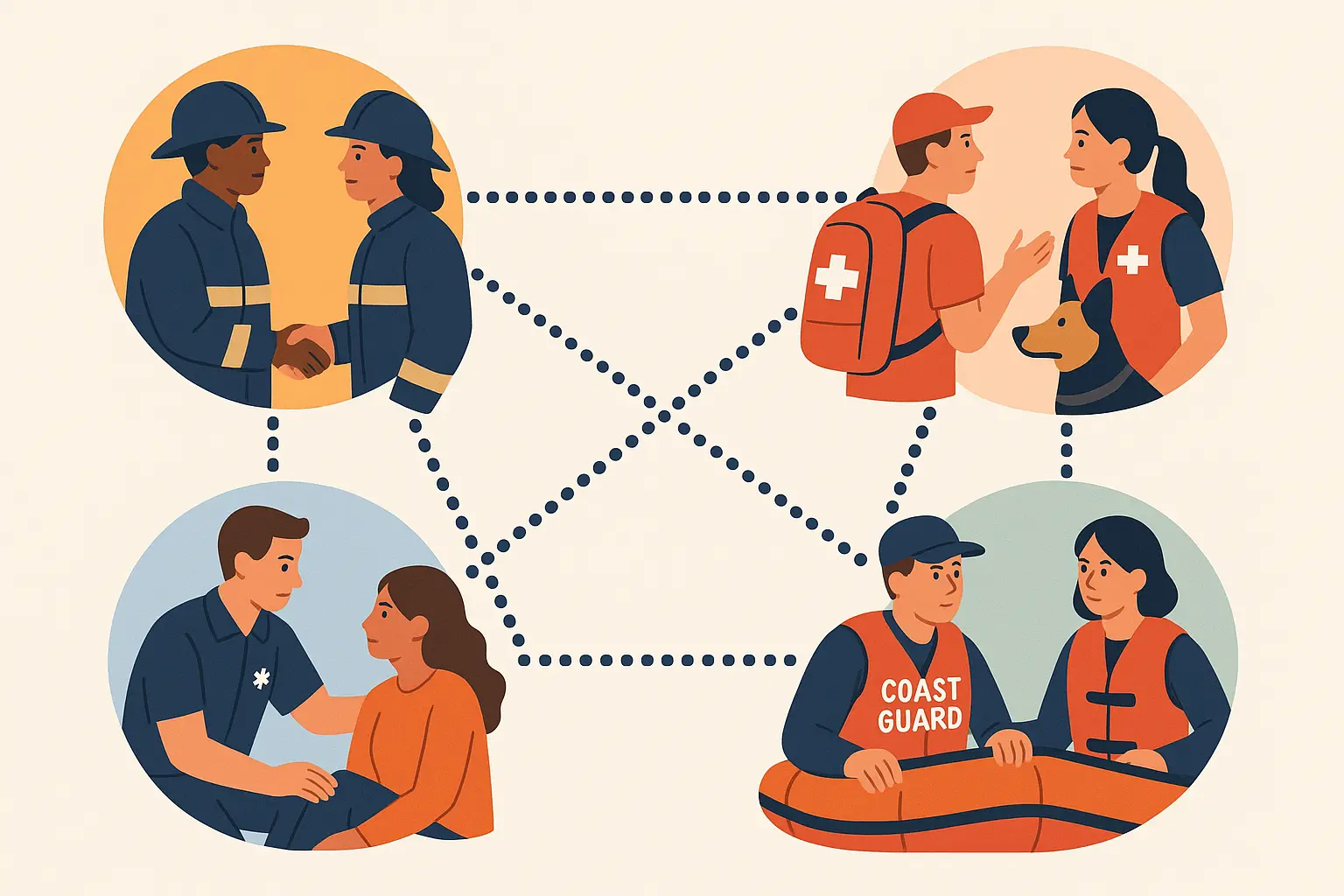
These partnerships provide diverse expertise, shared resources, and backup capacity when individual organizations become overwhelmed. The most successful rescues establish coordination protocols before emergencies occur.
Money That Doesn’t Run Out
Public-private funding partnerships provide the most sustainable support for long-term rescue efforts. Programs relying on single funding sources face a 45% failure rate within five years, while diversified funding approaches maintain operations through economic downturns and changing priorities.
Successful programs combine government grants, private donations, corporate sponsorships, and fee-for-service activities to create stable financial foundations. They also maintain emergency reserves for unexpected crises or opportunities.
| What Makes or Breaks Rescues | The Winners | The Ones That Fail | What Difference It Makes |
|---|---|---|---|
| Working Together | 5+ organizations coordinated | Going it alone | 340% better success rates |
| Money Sources | Multiple funding streams | Depending on one donor | 55% more likely to survive 5 years |
| Using Science | Collecting research data | Just winging it | 78% improvement in techniques |
| Training Volunteers | Formal training programs | Learning on the job | 60% less stress on animals |
| Planning Ahead | 10+ year strategic plans | Making it up as they go | 200% better long-term survival |
| Getting the Word Out | Active public outreach | Keeping quiet | 150% more public support |
Science That Makes Things Better
Rescue programs that integrate scientific research show consistently better outcomes because they contribute data that improves techniques over time. Marine mammal rescues provide 78% of valuable conservation data while treating individual animals. Wildlife conservation efforts use genetic analysis to guide breeding programs and population management.
This research integration creates feedback loops that continuously improve rescue protocols and success rates. The best programs publish their findings and share techniques with other organizations.
The Mistakes That Kill Programs
Insufficient long-term funding causes 45% of rescue programs to fail within five years. Lack of specialized facilities limits rehabilitation success to just 23% without proper housing. Poor volunteer training increases animal stress and reduces success rates. Bad coordination between agencies delays response times by an average of 72 hours during critical rescue operations.
Understanding these failure points helps organizations design more effective programs. The most successful operations learn from failures and continuously refine their approaches.
How Nairrate Helps Tell Stories That Stick
If you’ve got your own rescue story burning inside you, or you work with an organization that needs help sharing these incredible moments with the world, you know how hard it can be to find the right words. How do you capture the 3 AM bottle feeding of an orphaned seal pup? How do you make people understand what it feels like when a traumatized animal finally trusts a human again?
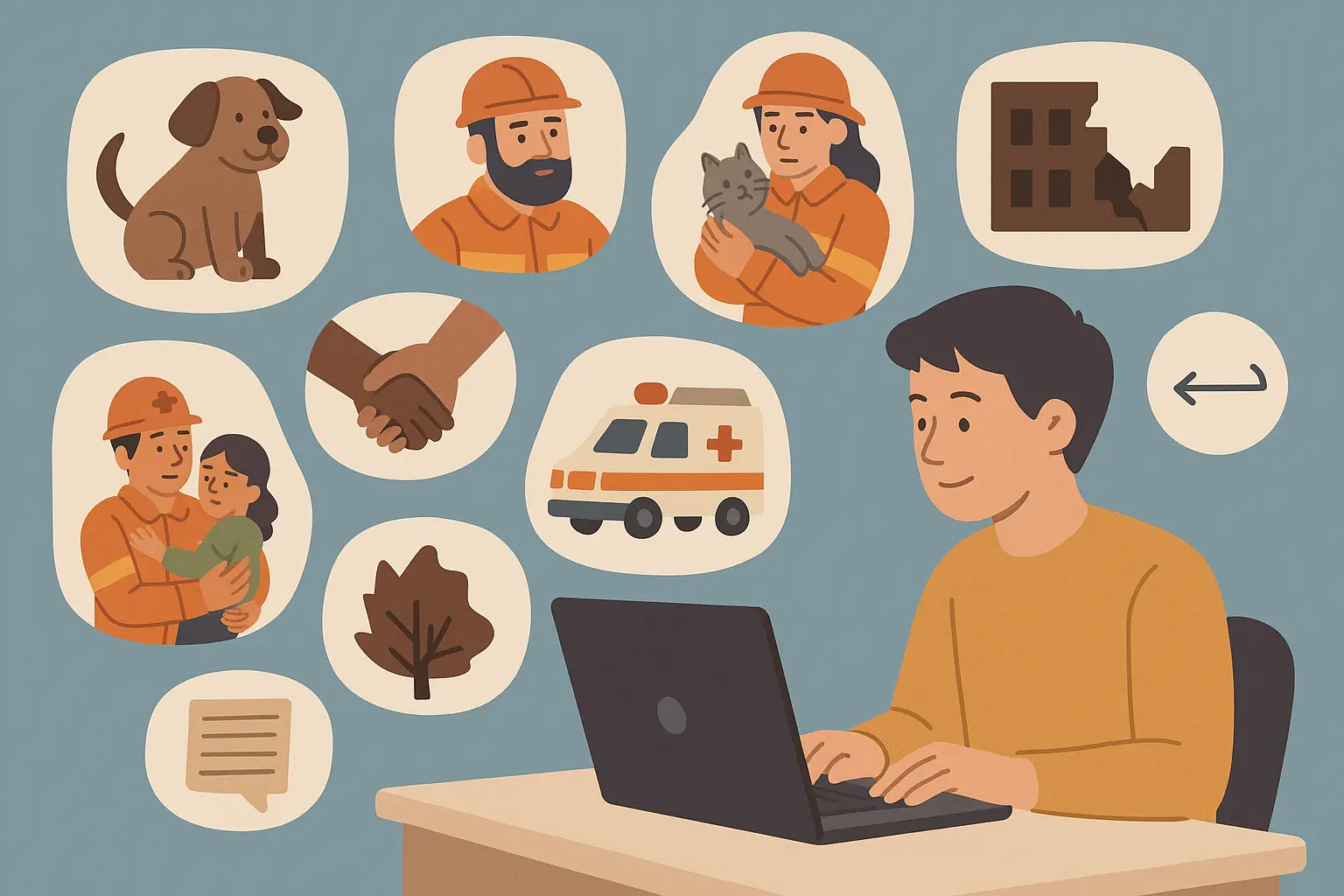
That’s where storytelling tools can make all the difference. Nairrate’s AI-powered Story Starters Generator and Story Prompt Generator help create compelling opening lines that immediately draw readers into rescue narratives—from emergency calls at 3 AM requiring immediate animal evacuation to customs officers discovering illegal wildlife shipments.
The Story Prompt Generator develops fresh angles on familiar rescue scenarios while helping you explore character depth for both animals and their rescuers. Whether you’re documenting rescue success stories, covering animal welfare issues, or raising awareness about conservation efforts, crafting compelling narratives requires balancing emotional resonance with authentic detail.
Just as must-read animal stories for kids demonstrate the power of animal narratives to teach empathy and compassion, adult animal rescue stories can inspire real-world action when crafted with the right balance of emotion and information.
Nairrate understands the elements that make animal rescue stories compelling and helps you structure narratives for maximum emotional impact while finding the perfect balance between heartwarming moments and educational content. The platform doesn’t replace your unique vision—it enhances your ability to share these crucial stories with the world.
Every rescue deserves to be told in a way that honors both the struggle and the hope. Ready to transform your animal rescue storytelling? Try Nairrate today and discover how our AI story generator can help you craft powerful narratives that honor the incredible bonds between humans and animals while inspiring others to join rescue and conservation efforts.
Final Thoughts
Here’s what gets me about these 25 rescue stories: they prove that the most impossible things are just waiting for someone stubborn enough to try. From 27 condors becoming 500+ birds to 15,000 volunteers showing up for Hurricane Katrina pets, each story shows what happens when people decide that giving up isn’t an option.
The most impactful rescues don’t just save individual animals—they change how we think about our relationship with other species. Multi-organizational partnerships, diversified funding, and scientific research integration separate programs that last from those that fail within five years. But underneath all the logistics and strategy, it’s really about people who see suffering and can’t walk away.
Whether you’re involved in rescue work, supporting conservation efforts, or just sharing these stories with friends, remember that every single rescue started with someone who looked at a bad situation and thought, “This isn’t okay.” Sometimes that’s all it takes to change a life—or save a species.
The best rescue stories don’t manipulate your emotions or oversimplify complex problems. They show you the real work: the 2 AM feedings, the heartbreaking setbacks, the volunteers who show up year after year, and the moment when an animal who’d given up on humans decides to trust again.
That’s the stuff that changes the world, one rescue at a time.



Add comment